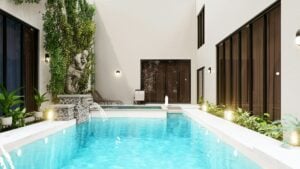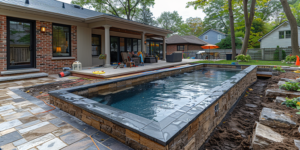Retaining walls are essential components in many landscaping projects, particularly those featuring elevation changes or requiring slope stabilization. These functional structures not only provide necessary support for soil and vegetation, but they can also add an aesthetically pleasing element to your outdoor space when integrated thoughtfully into your landscape design. In this article, we will discuss the main types of retaining walls, their advantages, and appropriate uses, ultimately helping homeowners understand their options when embarking on a landscaping project involving slopes, hills, or terraces.
Whether you seek enhanced aesthetics, increased usable space, or improved drainage management, exploring the various types of retaining walls and their benefits will empower you to make informed decisions that elevate your landscape design. As you learn about the different retaining wall materials, construction methods, and unique advantages, you’ll be well-equipped to select the ideal structure that not only addresses practical needs but also blends seamlessly with your property’s style and ambiance.
Gravity Retaining Walls
Gravity retaining walls rely on their own weight and mass to hold back soil and stabilize slopes. Typically constructed with heavyweight materials such as stone, brick, or concrete, these walls provide a durable solution for landscape challenges.
- Benefits
Gravity walls offer a variety of advantages, including cost-effectiveness and ease of installation. Due to their simple design, homeowners can often construct these walls using readily available materials without specialized equipment or masonry skills. Moreover, gravity walls can add texture and visual appeal to your landscape, enhancing the overall aesthetic value of the property.
- Best Uses
Gravity retaining walls are suitable for projects with relatively low height constraints, typically up to 4 feet. Common applications include supporting garden beds and small terraces, leveling uneven landscapes, and providing erosion control on sloping properties.
Cantilever Retaining Walls
Cantilever retaining walls consist of a reinforced concrete wall and a footing that extends beneath the retained soil, providing additional support. The cantilevered design allows the wall to resist pressure from the soil, making it a reliable solution for more substantial projects.
- Benefits
Cantilever walls offer improved strength and durability compared to gravity walls, particularly in areas with challenging ground conditions or higher load requirements. Additionally, they require a smaller amount of material to achieve the same level of stability, making them a more space-efficient and cost-effective option.
- Best Uses
Cantilever retaining walls are best suited for projects that require walls over 4 feet in height and in areas where stronger support is needed. Common applications include stabilizing hillsides, retaining embankments near roadways, and creating large terraces for tiered gardens or patios.
Sheet Pile Retaining Walls
Sheet pile retaining walls are thin, vertical walls constructed of overlapping steel, vinyl, or composite materials. They are driven into the ground and held in place by the pressure and friction between the soil and the piling material.
- Benefits
Sheet pile walls are an efficient solution for tight, narrow spaces and offer increased durability and corrosion resistance, especially when using steel or composite materials. They also provide a faster installation compared to other retaining wall types.
- Best Uses
Sheet pile walls are ideal for applications where space is limited, such as along property lines or in between structures. They are particularly well-suited for coastal applications where water and soil pressure requires additional reinforcement, or for constructing temporary walls during construction projects.
Anchored Retaining Walls
Anchored retaining walls combine the elements of other wall types with the added support of anchors or tiebacks. These walls provide increased stability through the installation of soil or rock anchors, which are embedded into the ground behind the wall and secured to the wall system.
- Benefits
Anchored walls offer increased stability and strength, making them a versatile solution for various soil conditions and locations. These walls can be used in conjunction with other wall types to provide additional reinforcement, making them highly adaptable to a range of project requirements. Additionally, anchors can be installed at varying depths, offering a more customized level of support.
- Best Uses
Anchored retaining walls are best suited for applications where soil conditions or external pressures require added reinforcement, such as in areas with heavy rainfall or seismic activity. They are also recommended for constructing walls in difficult-to-reach locations, such as steep hillsides or tight spaces.
Choosing the Right Materials
Selecting the appropriate materials for your retaining wall can significantly impact its aesthetics, durability, and performance. Below are some popular material options to consider:
- Natural Stone
Natural stone offers a timeless, organic look and can be used to create gravity walls or veneer over other wall types. Common stone choices include granite, limestone, or sandstone.
- Concrete Blocks
Concrete block walls are versatile and easy-to-install, providing a durable solution for various retaining wall needs. They come in an array of colors, shapes, and textures, allowing homeowners to achieve a custom look that blends seamlessly with their landscape design.
- Wood
Wood retaining walls, such as landscape timbers or railroad ties, provide a more affordable and visually appealing option. However, they are often less resistant to moisture, decay, and insects, and may have a shorter lifespan compared to other materials.
Partner with Pinnacle Pools and Landscape for Your Retaining Wall Solutions
It’s essential to choose the most suitable retaining wall design and materials for your landscaping project to achieve the desired aesthetics, functionality, and durability. Evaluating the unique advantages and appropriate applications of gravity, cantilever, sheet pile, and anchored retaining walls can empower you to select the ideal structure that addresses both your practical needs and design preferences.
Pinnacle Pools and Landscape has a team of highly skilled and experienced professionals who specialize in designing, constructing, and installing retaining walls to enhance your residential or commercial landscape. Serving Elk Grove, Sacramento, Folsom, and the surrounding areas, our commitment to quality workmanship and exceptional customer service will ensure your retaining wall project is carried out with precision and care. If you are planning a landscaping project that requires the expertise and guidance of seasoned retaining wall specialists, contact us today to get started!













